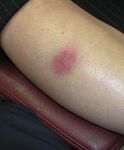- Acne
- Actinic Keratosis
- Aesthetics
- Alopecia
- Atopic Dermatitis
- Buy-and-Bill
- COVID-19
- Case-Based Roundtable
- Chronic Hand Eczema
- Chronic Spontaneous Urticaria
- Drug Watch
- Eczema
- General Dermatology
- Hidradenitis Suppurativa
- Melasma
- NP and PA
- Pediatric Dermatology
- Pigmentary Disorders
- Practice Management
- Precision Medicine and Biologics
- Prurigo Nodularis
- Psoriasis
- Psoriatic Arthritis
- Rare Disease
- Rosacea
- Skin Cancer
- Vitiligo
- Wound Care
Article
Nail Bacteria lurks in salon treatments
Despite heightened efforts to boost sanitation awareness, nail salons and manicures can still be perfect conveyors of bacterial infections. Pedicure spas can be particularly ideal places for atypical mycobacterium to thrive, and several states have cracked down on regulations to prevent infection outbreaks.

Key Points

The main culprit for the spread of bacterial infections, fungus and probably viral warts is the sharing of instruments that have been improperly cleaned or sterilized. But some instruments should not be shared even under the best of sterilization procedures, says Phoebe Rich, M.D., a dermatologist practicing in Portland, Ore.
Fungus and probably viral warts "can be transmitted through the reuse of nonsterilizable porous implements, such as files, pumice stones, etc.," Dr. Rich tells Dermatology Times.
File facts
While most salonworkers know that cardboard files cannot be sterilized because they fall apart if soaked or autoclaved, they may not realize the risks in sharing the instruments among clients.
"(Some) may not know that files can carry spores and viral particles from person to person. The files should be disposed of after each client, but that doesn't always happen," Dr. Rich says.
Sharp snippers and clippers, credo blades and pushers can accidentally cut the skin, and while evidence is still sketchy, the spread of disease from blood-borne pathogens, such as hepatitis, from person to person is a strong possibility, Dr. Rich adds.
"It is hard to trace the source of blood-transmitted diseases like hepatitis, but salons are a potential source of blood transmission when cuts and nicks in the skin can contaminate implements," Dr. Rich says.
Electric drills, used on multiple clients, can also theoretically injure the skin.
Atypical mycobacterium, which can result from use of pedicure spas that are not kept sanitary, is among the most common causes of infections, Dr. Rich says.
"(Atypical mycobacterium) is often misdiagnosed and treated with antibiotics that usually treat common skin infections," Dr. Rich says. "But this infection does not respond to the usual antibiotics."
Safety information
The Nail Manufacturers Council offers comprehensive safety information for patients and nail care professionals, as does the Environmental Protection Agency. Several states enacted mandatory spa sanitation laws following a 2000 outbreak in California in which more than 150 cases of skin boils caused by Mycobacterium fortuitumwere linked to pedicure foot spas. Mycobaterium fortuitum naturally occurs in the soil and in water.
Following the outbreak, Illinois health officials conducted field tests of random salons in their own state and found that a significant percentage of the salons' pedicure whirlpools tested positive for the bacteria.
A 2005 testing of 30 footbaths at 18 nail salons in California found mycobacteria in no less than 29 (97 percent) of the footbaths, with Mycobacterium fortuitum being the most common. (Emerg Infect Dis. 2005 Apr).
The tubes and screens of foot spas offer particularly good places for bacteria and biofilm to grow and collect, and salons are advised to use EPAregistered hospital disinfectant between each client.
Shaving, using hair removal creams or waxing the legs during the 24 hours before receiving a foot spa treatment should be avoided in order to prevent microorganisms in foot spas from entering the skin. Clients are also advised not to use foot spas if the skin has any open wounds, including bug bites, bruises, scratches, cuts, scabs or poison ivy.
To prevent infections, some high end salons now give or sell personal packs of implements which are only used on one client. Also, salons are increasingly using higher-end pedicure "thrones" that don't have pipes and fillers that typically tend to collect debris and mycobacteria.
"The problem is that (the thrones) are very expensive and most salons cannot afford to trade in the old pedicure spas," Dr. Rich says.
For salons that use the more conventional pedicure spas, the Nail Manufacturers' Council recommends circulating a bleach solution through the pump every 15 minutes to kill organisms. Most salons, however, and especially discount salons that rely on volume, cannot afford to spend time on that and stay in business.
Tips for patients
When discussing with patients the precautions for nail products and salons, Dr. Rich suggests offering the following tips:
1. Use only licensed nail technicians and licensed salons.
2. Wash hands before any nail salon services.
3. Look for cleanliness in the salon.
4. Ask about sanitization and sterilization in the salon.
5. Bring your own instruments, particularly files that cannot be sterilized.
6. If you experience any itching or burning after a service, it could signal a reaction.
7. Allergy to nail polish can show up on the face and eyelids, and neck.
8. Keep nail extensions short.
9. Do not allow the tech to file the surface of the nail plate in preparation for extensions or enhancements. It weakens the nail.
10. Wear gloves for all wet work chores to protect the manicure and help prevent infections associated with artificial enhancements.
11. If you experience a nick or cut during a salon procedure, seek medical attention to avoid infections.
12. To prevent infection, do not shave your legs before a pedicure.
Newsletter
Like what you’re reading? Subscribe to Dermatology Times for weekly updates on therapies, innovations, and real-world practice tips.











